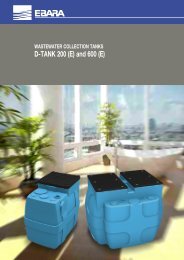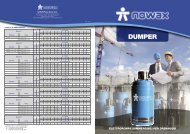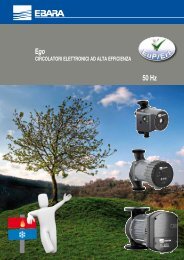i gruppi di pressurizzazione gp gp pressure booster sets groupes de ...
i gruppi di pressurizzazione gp gp pressure booster sets groupes de ...
i gruppi di pressurizzazione gp gp pressure booster sets groupes de ...
You also want an ePaper? Increase the reach of your titles
YUMPU automatically turns print PDFs into web optimized ePapers that Google loves.
The set must be positioned on a flat protected surface, in<br />
areas of limited access, and with sufficient working space<br />
around it to allow maintenance and removal. If it is not<br />
provi<strong>de</strong>d with vibration dampers, the set may be anchored<br />
to the ground with foundation bolts.<br />
• The connecting pipes must have a <strong>di</strong>ameter at least<br />
equal to, or at any rate not smaller than, the suction and<br />
<strong>de</strong>livery manifolds of the set; they must be as short and<br />
straight as possible, always with an ascen<strong>di</strong>ng path<br />
towards the pumps, using the smallest number of bends,<br />
avoi<strong>di</strong>ng goosenecks which can cause siphons or air<br />
pockets. It is recommen<strong>de</strong>d to use sufficiently rigid<br />
metal pipes, to avoid sagging.<br />
• All the threa<strong>de</strong>d or flanged connections must be well<br />
sealed to prevent air infiltration.<br />
• Supports, anchorings points, pipes and other system<br />
components must be in<strong>de</strong>pen<strong>de</strong>nt of the set, so that<br />
they do not cause further loads or stress on the set.<br />
• It is advisable to fit an isolating valve imme<strong>di</strong>ately<br />
downstream from the set;<br />
• To avoid vibrations in the system pipes it is<br />
recommen<strong>de</strong>d to fit vibration-damping couplings on the<br />
suction and <strong>de</strong>livery of the set.<br />
• Always install a foot valve when installing above-head.<br />
• For set testing requirements, downstream add a T with<br />
interception valve and respective recirculating pipe<br />
towards the suction tank or into a drain.<br />
9.1 CONNECTION TO PRESSURE VESSELS<br />
Depen<strong>di</strong>ng on the number of pumps, it is possible to fit<br />
<strong>di</strong>aphragm tanks with capacity up to 24 litres on the<br />
<strong>de</strong>livery manifold. These must be assembled on special G<br />
1 couplings. It is recommen<strong>de</strong>d to fit <strong>di</strong>aphragm tanks in<br />
compliance with Directive 97/23/CE. If using <strong>di</strong>aphragm<br />
autoclaves with larger <strong>di</strong>mensions (of the preloa<strong>di</strong>ng type<br />
or fed by a compressor), the connection must be ma<strong>de</strong> at<br />
the end of the <strong>de</strong>livery manifold. For autoclaves of the air<br />
cushion type, the automatic fee<strong>de</strong>r must be connected<br />
with the G1/2 coupling provi<strong>de</strong>d between the check valves<br />
and the pump suction apertures. However, see the<br />
instructions manual for the <strong>di</strong>aphragm tanks.<br />
9.2 PRIMING<br />
Operation to be carried out with the set<br />
ATTENTION!<br />
completely isolated from the electrical supply.<br />
• Set with positive head (drawing from a tank at a level<br />
higher than the pump suction aperture),<br />
Open the isolating valves on the set suction and close<br />
those on <strong>de</strong>livery. Remove the bleed plug from the hole at<br />
the top of the pumps and wait for water to come out. If<br />
there is not overflow (e.g. horizontal draught) from the<br />
check valve, fill till water overflows from the hole at the top<br />
of the pumps, then close with the cap provi<strong>de</strong>d.<br />
• Set with negative head ( drawing from a tank at a level<br />
lower than the pump suction aperture).<br />
Open the isolating valves on the set suction, remove the<br />
bleed plug from the hole at the top of the pumps and fill to<br />
overflowing.<br />
10. ELECTRICAL CONNECTION<br />
ATTENTION!<br />
NB: the electric connection must be carried<br />
out by a skilled technician.<br />
The wiring <strong>di</strong>agram insi<strong>de</strong> the control panel corresponds to<br />
12 – GP<br />
the functions for which the panel is provi<strong>de</strong>d. The mains<br />
must be efficiently earthed accor<strong>di</strong>ng to the electrical<br />
standards in force in the country of use and for the type of<br />
system connected; the installer is responsible for this.<br />
Make the earth connection before any other operation.<br />
For the connection to the power mains, use power cables<br />
complying with IEC standards, with a section necessary for<br />
characteristics of the panel and of the system.<br />
10.1 ELECTRIC PANEL<br />
The <strong>sets</strong> may be equipped with single-phase electric control<br />
panels, three-phase panels with <strong>di</strong>rect start, three-phase panels<br />
with star <strong>de</strong>lta start (Y∆), with thermoplastic or metal casing,<br />
<strong>de</strong>pen<strong>di</strong>ng on the size, cable clamp outlet, <strong>de</strong>gree of<br />
protection IP55. The electric components for the protection of<br />
the auxiliary circuits operate at very low voltage, they are easy<br />
to replace and are available on the market. All the panels have<br />
the possibility of inputs for level gauge/ minimum <strong>pressure</strong><br />
switch and alarm output; they also have a <strong>de</strong>vice for inverting<br />
the starting or<strong>de</strong>r of the motors. Three-phase panels with star<br />
<strong>de</strong>lta start are equipped with line contactors, star contactor,<br />
<strong>de</strong>lta contactor, timers with exchange time adjustable.<br />
The power supplies are:<br />
• Single-phase 1~50/60 Hz 230V±10%;<br />
• Three-phase 3~50/60 Hz 400V±10%.<br />
For the characteristics and wiring <strong>di</strong>agram, see the separate<br />
manual for the electric panel supplied with the set.<br />
In fig.2 single-phase panel for <strong>sets</strong> with 2 pumps, fig.3<br />
wiring <strong>di</strong>agram.<br />
In fig.4 three-phase panel for <strong>sets</strong> with 3 pumps, fig.5<br />
wiring <strong>di</strong>agram.<br />
Fig.2<br />
A: green warning led, live;<br />
B: green warning led, motor 1 operating;<br />
C: green warning led, motor 2 operating;<br />
D: red warning led, alarm;<br />
E-F: selectors and/or levers/buttons for operating motors 1,<br />
2 “AUTO-OFF-MANUAL”;<br />
G-H: reset of motor thermal protections (in the threephase,<br />
<strong>di</strong>rect start and star <strong>de</strong>lta start types, the buttons are<br />
insi<strong>de</strong> the panel;<br />
I: list of mo<strong>de</strong>ls;<br />
L: general isolating switch with door blocking <strong>de</strong>vice, may<br />
be padlocked in “OFF” position.





